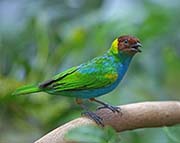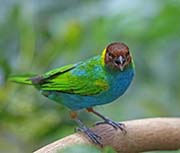Bay-headed Tanager - Tangara gyrola
| Length | |
| Weight | |
| Clutch Size | |
| Chicks at birth | |
| IUCN Conservation Status | |
Continents: |
The Bay-headed Tanager is found in parts of Central America and the northern half of South America. They are a colorful bird and the plumage color varies among the nine subspecies. The head is rufous (chestnut). Most subspecies have a yellow-gold collar that separates the rufous head from the body. The width of this collar varies depending on the subspecies. Many of the subspecies upperparts are green or green and yellow and the underparts are turquoise green. Variations on the presence and amount of yellow, green and turquoise varies. Sexes are similar and juveniles are duller with less rufous on their heads. They may be mostly green.
They are considered social birds and will travel in small flocks with other birds.
Diet: Bay-headed Tanagers eat fruit and will feed with other bird species at the same fruit tree. Small fruits are swallowed whole. Insects are also eaten from tree limbs.
Courtship:
Nesting: The female builds the open bulky-shaped cup nest by herself but the male may bring nest material (mostly moss). She lays two whitish eggs with brown splotches and incubates them. Both parents feed the young.
Habitat and Range: Bay-headed Tanagers are found in Costa Rica, Panama, and south to Ecuador, Bolivia and southern Brazil and on Trinidad. Inhabit low-lying humid forests. They will also inhabit coffee plantations and second growth.
Vocalization: Vocalization include a short scratchy high-pitched 'tssit'.
Plumage/Molt Bay-headed Tanagers do not have an alternate plumage and molt annually.
Migration: Non-migratory but it is believed that it will move seasonally in some areas to locate fruit.
Tongue/feet: Gray legs and feet.
Bibliography:
- http://en.wikipedia.org The Free Encyclopedia, Accessed December, 2012
- Isler, Morton L. and Isler, Phyllis R., The Tanagers: Natural History, distribution, and Identification,Smithsonian Institution Press, Washington D.C., 1987




